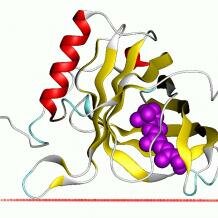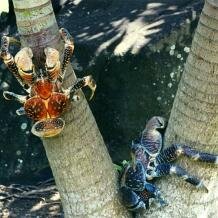Topic: Olfaction: insights into convergence
Although olfaction is very widespread, there is abundant evidence for repeated convergence of key features, strongly suggesting that there really is an optimal solution to detecting smells.
Olfaction is very widespread, and occurs in both aquatic and terrestrial organisms. In many animals it is clearly of central importance. To give just two examples: The extraordinary navigational abilities of the far-ranging pelagic seabirds, especially across the seemingly trackless wastes of the Southern Ocean, are evidently mediated by the detection of key odour compounds, including dimethyl sulphide. Correspondingly in the ocean, nautiluses, well known for their pinhole camera eye (which has evolved multiple times), are evidently highly olfactory animals and most likely this is their principal sensory modality.
Convergent features of olfaction
Nevertheless, there is abundant evidence for repeated convergence of key olfactory features. A particular focus of attention has been the series of striking similarities between the olfactory circuits in fruit flies and mammals. However, many other features should also be noted that together strongly suggest that there really is an optimal solution to detecting smells.
Olfactory receptors
The basis of olfaction is typically a series of hair-like extensions from the receptor area that are enclosed in a fluid-filled cavity. It is in this environment that olfactory molecules are trapped and assessed. It is evident that this common design has evolved independently many times.
 An important stage in olfaction is, of course, getting the molecule that is to be detected to the olfactory receptor. This is achieved using olfactory binding proteins, and amongst these of key importance in the vertebrates are the lipocalins (which are also convergently employed in milk in insects and mammals). Lipocalins are particularly suitable because of their small size and capacity to bind ligands. Although insects also employ olfactory binding proteins and possess lipocalins, oddly they rely on completely unrelated proteins, but ones with all the key properties seen in the vertebrate equivalents. Another important and related area concerns pheromone recognition, widespread in vertebrates and insects, which use closely analogous, but convergent, systems. In this context we also see other intriguing parallels including those in the recognition of pheromonal cues in fish and insects.
An important stage in olfaction is, of course, getting the molecule that is to be detected to the olfactory receptor. This is achieved using olfactory binding proteins, and amongst these of key importance in the vertebrates are the lipocalins (which are also convergently employed in milk in insects and mammals). Lipocalins are particularly suitable because of their small size and capacity to bind ligands. Although insects also employ olfactory binding proteins and possess lipocalins, oddly they rely on completely unrelated proteins, but ones with all the key properties seen in the vertebrate equivalents. Another important and related area concerns pheromone recognition, widespread in vertebrates and insects, which use closely analogous, but convergent, systems. In this context we also see other intriguing parallels including those in the recognition of pheromonal cues in fish and insects.
It might be thought that olfactory receptor molecules march hand in hand with the nose, and so mostly they do. However, when one recalls how widely distributed some molecules are (think of neuroglobins, for example), then it comes as less of a surprise that olfactory proteins turn up in some apparently unexpected places, notably sperm. Unexpected that is until we consider the central role of chemotaxis in fertilisation – best to know where one is going in these circumstances.
Sensory transduction
Transduction of the olfactory signals depends on the classic seven helical transmembrane proteins, familiar in other contexts such as the visual opsins. Extraordinarily the arthropods have evolved a completely novel protein for transduction that is strikingly convergent with the standard arrangement. This is clearly of a separate origin because its terminal ends (amino (N) and carboxyl (C)) are reversed, and not surprisingly there is no sequence similarity. It is rather mysterious why the arthropods have gone to the trouble to invent a new protein (which is related to a number of cation-channel proteins) when the opsins are readily available in the eyes and could have been recruited in the same way as in other animals. These novel olfactory proteins are also found in the gustatory (taste) modality of arthropods.
Neural circuits
The neural circuitry involved in olfaction in insects and mammals has a number of intriguing similarities, including the conduction of the nerve cells to specific neural areas known as glomeruli (which are located in the antennal lobe in insects and in the olfactory bulb in mammals). This is evidently convergent, and a nice independent test involves the robber crabs or coconut crabs (Birgus latro). These are crustaceans, but unlike the great majority are effectively entirely terrestrial. Their olfactory equipment turns out to be strikingly similar to that of the insects, but has evolved independently.
Laterality
An interesting aspect of olfactory discrimination that has evolved several times is evidence for a distinct laterality. This has been identified in groups as disparate as birds (chicken) and insects (bees), whilst in humans the airflow into each nostril results in a slightly different olfactory “image”. Bilateral aspects of olfaction are also interesting, and in the case of rats there is good evidence that they smell in stereo.
Qualia
All sensory modalities involve the mystery of qualia, the “is-ness” of a sensation, be it a rainbow or music. This finds a special force in olfaction and the associated intangibility of smells and odours, some of which may re-open memories thought to be long forgotten. The entire question of olfactory qualia is both fascinating and also deeply frustrating, and it is interesting to see how investigators who have documented the many intricacies of this modality are sometimes lost for words, literally.
Links with taste
 Whilst separate, there are clearly close links between olfaction and gustation (taste), and the latter, of course, introduces many more remarkable examples of convergence. Particularly interesting is the rather surprising ability to be able to detect a gas, specifically carbon dioxide (CO2). This is best known in mosquitoes, where it is important for the female to find vertebrate prey. Most likely in fruit flies this ability has evolved independently, and is actually based on a gustatory receptor, but one that is embedded in the olfactory system. In some contexts the detection of CO2 invokes an avoidance reaction, but in the case of dissolved CO2 the reaction to this carbonation is positive, and probably linked to the detection of yeasts or other microbes as a food source. CO2 detection is not restricted to the dipterans, but is also found in the hawkmoths. They use it as a cue for newly opened flowers, which emit enhanced quantities of this gas.
Whilst separate, there are clearly close links between olfaction and gustation (taste), and the latter, of course, introduces many more remarkable examples of convergence. Particularly interesting is the rather surprising ability to be able to detect a gas, specifically carbon dioxide (CO2). This is best known in mosquitoes, where it is important for the female to find vertebrate prey. Most likely in fruit flies this ability has evolved independently, and is actually based on a gustatory receptor, but one that is embedded in the olfactory system. In some contexts the detection of CO2 invokes an avoidance reaction, but in the case of dissolved CO2 the reaction to this carbonation is positive, and probably linked to the detection of yeasts or other microbes as a food source. CO2 detection is not restricted to the dipterans, but is also found in the hawkmoths. They use it as a cue for newly opened flowers, which emit enhanced quantities of this gas.
Cite this web page
Map of Life - "Olfaction: insights into convergence"
https://mapoflife.org/topics/topic_320_olfaction-insights-into-convergence/
March 3, 2021

